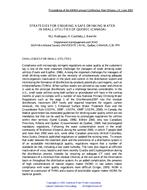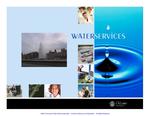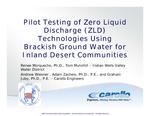Provide PDF Format
AWWA ACE56271
- Strategies for Ensuring a Safe Drinking Water in Small Utilities of Quebec (Canada)
- Conference Proceeding by American Water Works Association, 06/16/2002
- Publisher: AWWA
$12.00$24.00
Compliance with increasingly stringent regulations on water quality at the customer's tap is one of the most important challenges for managers of small drinking water utilities. Among the important challenges for managers of small drinking water utilities are the necessity of simultaneously ensuring adequate micro-organism inactivation in the plant and control in the distribution system and minimizing the formation of disinfection byproducts potentially carcinogenic, such as trihalomethanes (THMs). When surface waters are utilized as raw water and chlorine is used as the principal disinfectant, such a challenge becomes considerable. In the U.S., small water utilities using both surface or groundwater will have in the coming months or years to comply with a number of new National Primary Drinking Water Regulations such as the stage 1 of the Disinfectants/DBP rule (for residual disinfectant, maximum DBP levels and required treatment for organic carbon removal), the long term 1 Enhanced Surface Water Treatment Rule and the Groundwater Rule. In Canada, the federal government has elaborated guidelines for drinking water quality which are not mandatory but that can be used by Provinces to promulgate regulations for utilities within their territory. Before 2000, only two Canadian Provinces, Alberta and Quebec had promulgated mandatory regulations. Following the water contamination event in the small community of Walkerton (Ontario) during the summer 2000, in which 7 people died and more than 2,000 were sick, some other Canadian provinces (British Columbia, Nova Scotia, Ontario) published regulations or updated the existing ones. To ensure that water between the treatment plant and the extremities of a distribution system is of an acceptable microbiological quality, regulations require that a number of standards be met, including a low water turbidity. The rules also require an efficient inactivation of virus, bacteria and more recently Giardia and Cryptosporidium during the disinfection process (notably by ensuring an adequate CT vale) and the maintenance of a minimum free residual chlorine, at the exit point of the chlorination basin or throughout the distribution system. As an added complication, the presence of high concentrations of natural organic matter (NOM) in raw waters makes compliance with water quality regulations more difficult. NOM is known as a precursor of THMs and a source of assimilable organic matter (AOM) for bacterial growth. This paper discusses how small utilities in Quebec are meeting there requirements. Includes 10 references, tables, figures.
Related Products
AWWA MTC64637
The Ammonia- Carbon Dioxide Forward Osmosis Desalination Process: A High Recovery Alternative to Rev..
$12.00 $24.00
AWWA ACE70882
Pilot Testing of Zero Liquid Discharge (ZLD) Technologies Using Brackish Groundwater for Inland Dese..
$12.00 $24.00





